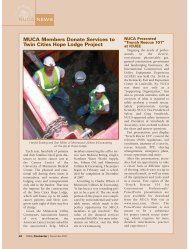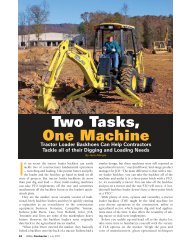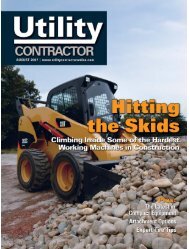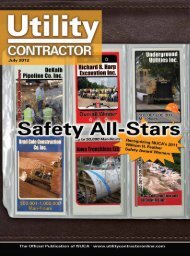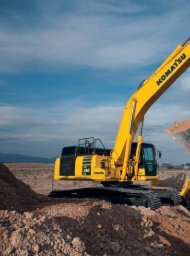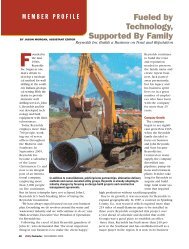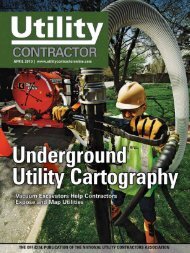SAFETY MANAGEMENTJob Safety Analysis 101By George KennedyWouldn’t you rather prevent an accident thaninvestigate it after the fact? That’s what JobSafety Analysis (JSA) is all about. Also knownas Job Hazard Analysis (JHA) or Activity HazardAnalysis (AHA), JSA is a simple, inexpensive and effectivemanagement tool that can be used to identify, analyzeand record: 1) the steps involved in performing a specificjob; 2) the existing or potential safety and health hazards associatedwith each step; and 3) the recommended action(s)/procedure(s) that will eliminate or reduce these hazards andthe risk of a workplace injury or illness. The benefits of JobSafety Analysis are well known: identification and eliminationor control of hazards before the work begins; consistentjob and safety training; improved employee safety performance;increased management awareness of safety hazards;improved labor and management cooperation; improvedcompliance with applicable regulations; and more accurateaccident investigations.Which Jobs Should Be Analyzed?Workers perform many different tasks as part of their jobclassifications — everything from setting up ladders and assemblingtrench shields to unloading trucks and entering confinedspaces. Each of these tasks involves different hazards that couldbe evaluated. So where to begin? Generally, it makes the mostsense to first select jobs that have a history of accidents, have thegreatest potential for serious injury, are frequently performed, areperformed by the greatest number of employees and are new tothose who will be performing them. Over a period of time, alljobs can be evaluated. Some jobs are routine and may require ageneral evaluation. Others may require a more in-depth evaluation.When tools, equipment, methods, procedures or jobsiteschange, some JSAs may have to be revised or updated.Here are just some of the hazards that should be consideredwhen completing a JSA: impact with a falling or flying object;penetration by sharp objects; caught in or between a stationary/movingobject; falls from an elevated work platform,ladders or stairs; excessive lifting, twisting, pushing, pulling,reaching or bending; repetitive motion; exposure to vibratingpower tools, excessive noise, cold, heat, harmful levels ofgases, vapors, liquids, fumes or dusts; exposure to cave-ins;32 <strong>Utility</strong> <strong>Contractor</strong> | <strong>July</strong> 2009electrical hazards; light (optical) radiation (e.g., welding operations);and water (potential for drowning or fungal infectionscaused by wetness).JSA MethodsThere are two basic JSA methods: group discussion and directobservation. A third method can be established by combiningthe two basic methods.The group discussion method requires the manager/foremanto meet with employees familiar with the job beinganalyzed. Each group member draws upon his/her experienceand visualizes the job steps and potential hazards.Sometimes photos or videos of a worker performing the jobare used to help stimulate the group members’ thought processes.They review the job from start to finish by breaking itdown into steps. The group evaluates each step to determinethe hazards that could lead to an accident.When the hazards are listed, the group focuses on the changesin the environment or procedures that can control or eliminatethe hazard. The advantages of the discussion method are themany points of view considered, increased worker knowledgeand increased worker involvement in company safety activities.Workers in the group are more inclined to promote and followthe established procedures if they are involved in creating them.A good time to create JSAs using this method is when work isslow and/or during inclement weather.As the name suggests, direct observation method involves observinga worker while he or she performs a specific task. Itis best to select an experienced employee who is willing to beobserved. The observer should list each step performed by theworker. Cameras and video cameras can be used to record thesteps for a more in-depth review, but don’t let taking the photographsbecome distracting to the worker. (Try not to use theflash attachment).The observer should then note the potential hazards connectedwith each step and try to identify changes in the environmentor work procedures that will eliminate potentialaccidents. There are several advantages to this method.The observer does not have to know how the job is performed,because he/she is watching and recording the work steps asthey are done. There is less interruption to the work because
SAFETY MANAGEMENTthe observations are performed while the work is in progress.Workers and observers (often managers) also tend toexperience improved knowledge, communications and mutualunderstanding.Performing the Job Hazard AnalysisA JSA has three basic phases: 1) list the steps required tocomplete the job; 2) identify the hazards associated witheach step; and 3) develop solutions for controlling or eliminatingthe hazards.Phase 1 – List the job steps. Every job must be brokendown into distinct steps in the order of occurrence. Documentenough information to describe each step, but do notmake the breakdown too detailed. Try to limit the numberof job steps to 10 or fewer well-defined steps. Each stepwill consist of a set of movements. For example, “Pick upbox and place on hand truck” or “Push hand truck to storagearea.” All steps should start with an action word — e.g.,push, pull, lift, move, carry, insert, tighten, etc. Review thesteps with experienced workers to ensure they are completeand descriptive.Phase 2 – Identify the hazards. Each step should be examinedto discover any existing or potential hazards. Whenlisting hazards, don’t just list the obvious hazards; list everyconceivable hazard that could reasonably cause an accident.Be sure to include health hazards, even though the potentialharmful effects may not be immediate.Phase 3 – Determine how to control or eliminate the hazard.Hazards must be reviewed and recommendations madeto eliminate or control them. Hazards can often be minimizedby: changing the sequence of steps; modifying or changingthe tools, machines, equipment or materials; implementingengineering controls; installing guards; changing methods;providing personal protective equipment; etc. In brief, whatwill make the job safer to perform? Be specific. Say exactlywhat needs to be done to correct the hazard, such as “lift usingyour leg muscles.” Do not use general statements like “becareful.” Provide a recommendation for each hazard. Also,list recommended safe operating procedures and appropriatepersonal protective equipment.Whatever JSA method is used the analysis should be properlydocumented (see www.maricopa.gov/safety/jsa_library.aspfor completed samples). Completed JSAs should be reviewedby managers, workers and the safety coordinators to ensurethat nothing has been overlooked. Executive managementor safety managers should approve any results that will becomepart of the safety program. Once approved, the JSAdocuments should be shared with all managers, foremen andsupervisors to ensure they are aware of established companyprocedures for specific jobs. Effective toolbox talks canbe created by selecting JSAs appropriate to a given jobsite.Workers tend to take great interest in training that is directlyrelated to what they are doing.Time and time again, job safety analysis has proven to be aneffective means of preventing accidents by finding and eliminatingor controlling hazards before the job is performed.JSAs can be used to train/retrain employees and foremen andto give pre-job instructions. It can help managers and supervisorsdevelop and improve job methods and procedures,not just in the area of safety, but often in other areas like productionand quality control. Its greatest value is in standardizingwork methods and safe operating procedures.For further information about how to complete a JSA,refer to OSHA’s Publication #3071 (www.osha.gov/Publications/osha3071.html).George Kennedy is NUCA Vice President of Safety.June 2009 | <strong>Utility</strong> <strong>Contractor</strong> 33National <strong>Utility</strong> <strong>Contractor</strong>s Association




